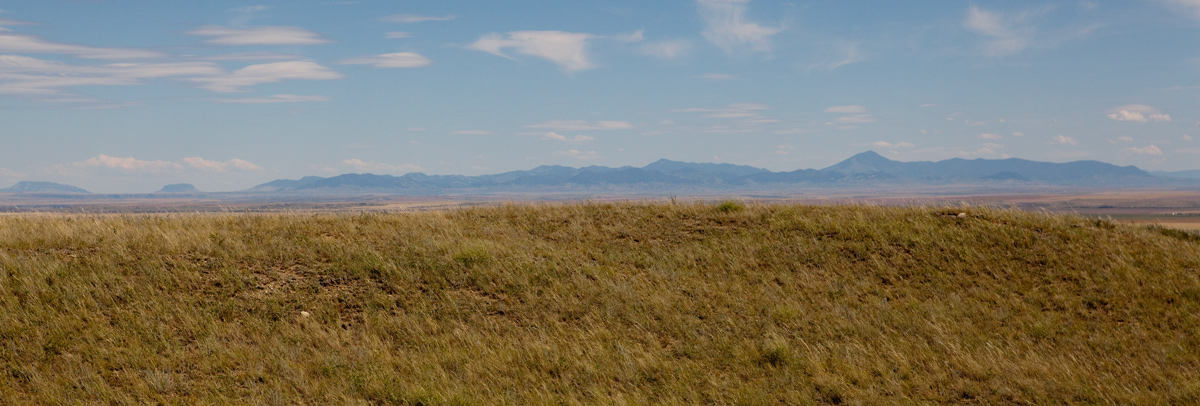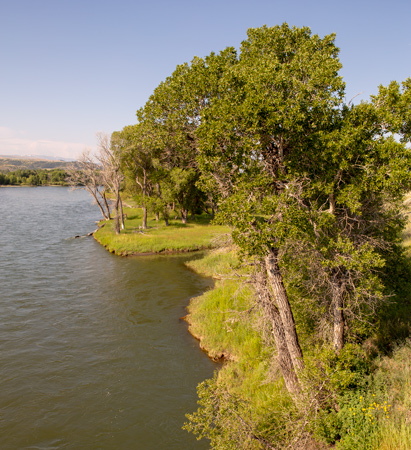On the plains between the Great Falls of the Missouri and the Marias River, Lewis and his small group sees a wounded bison, a sign that Indian hunters may be near.
On the Yellowstone River, Clark and his group scout for timber to make dugouts and sees an “Indian fort” used by traveling war parties. He camps near present Reed Point, Montana.
Sgt. Ordway leads a detachment down the Missouri navigating Pine Tree Rapids and passing Tower Rock. Sgt. Gass and his group wait for the arrival of the dugouts at the upper portage camp.[1]For more on the captains’ strategy and various groups after leaving Travelers’ Rest, see Dividing Forces at Travelers’ Rest.
Clark on the Yellowstone
by Yellowstone Public Radio[2]Originally aired weekdays by Yellowstone Public Radio during the Bicentennial observance of 2003-2006. Narrated by Hal Hansen. Scripts by Whit Hansen and Ed Jacobson. Produced by Leni Holliman. © … Continue reading
Lewis Crosses the Plains
Plains above the Teton River
View of the Bears Paw Mountains from Buck Bridge ridge, 21 July 2011. © by Kristopher K. Townsend. Permission to use granted under the Creative Commons Attribution-Share Alike 4.0 International license.
Drawing the Great Fall
I arrose early this morning and made a drawing of the falls. after which we took breakfast and departed.
—Meriwether Lewis
Wide and Level Plain
it being my design to strike Maria’s river about the place at which I left it on my return to it’s mouth in the begining of June 1805. I steered my course through the wide and level plains which have somewhat the appearance of an ocean, not a tree nor a shrub to be seen.
—Meriwether Lewis
Difficult Gumbo
the land is not fertile, at least far less so, than the plains of the Columbia or those lower down this river, it is a light coloured soil intermixed with a considerable proportion of coarse gravel without sand, when dry it cracks and appears thursty and is very hard, in it’s wet state, it is as soft and slipry as so much soft soap.
—Meriwether Lewis
Signs of Danger
on our arrival at the river we saw where a wounded and bleading buffaloe had just passed and concluded it was probable that the indians had been runing them and were near at hand. the Minnetares of Fort de prarie [Atsinas] and the blackfoot [Blackfeet] indians rove through this quarter of the country and as they are a vicious lawless and reather an abandoned set of wretches I wish to avoid an interview with them if possible.
—Meriwether Lewis
Small Cottonwood on the Yellowstone
Big Timber, Montana, 20 July 2017. © by Kristopher K. Townsend. Permission to use granted under the Creative Commons Attribution-Share Alike 4.0 International license.
Clark Looks for Timber
A Wet Night
The rain of last night wet us all. [Nicholas Biddle: having no tent, & no covering but a buffaloe skin] I had the horses all Collected early and Set out . . . .
—William Clark
Scouting for Timber
The high lands approach the river on either side much nearer than it does above and their Sides are partially covered with low pine & Cedar, none of which are Sufficently large for Canoes, nor have I Seen a Cotton[wood] tree in the low bottoms Sufficently large for that purpose.
—William Clark
An Indian Fort
I Saw in one of those Small bottoms which I passed this evening an Indian fort which appears to have been built last Summer. this fort was built of logs and bark . . . . the Squaw [Sacagawea] informs me that when the war parties find themselves pursued they make those forts to defend themselves . . . .
—William Clark
Gass has a Pleasant Day
We had a pleasant day, and high wind; which drives away the musquitoes and relieves us from those tormenting insects.
—Patrick Gass
Ordway Passes Tower Rock
From an interpretive sign at Tower Rock State Park. Photographed 2013 by Kristopher K. Townsend.
Dangerous Rapids
the wind rose So high that Some of the canoes were near being filled. about noon we arived at the head of the pine Islands & rapids & halted at the Creek above as the wind too high to pass these rapids with Safety.
—John Ordway
Big Horn Sheep
towards evening the wind abated a little So we passed down the rapids with Safety. at the foot of the rockey mountains large gangs of the Ibex or big horn [bighorn sheep] anim. Seen along the edges of Sd. Mountns.
—John Ordway
Weather Diaries
State of the weather at rise
Wind at rise
State of the weather at 4 P. M. Wind at 4 P. M. fair after thunder and lightning S W fair S W wind violent all day. distant thunder last evening to the West.
—Meriwether Lewis
State of the weather at Sun rise Wind at Sun rise State of the weather at 4 P. M Wind at 4 P M. fair after rain, hail, thunder & lightning S E fair S W Heavy showers of rain Hard Thunder & Lightning last night a heavy Shower of rain accompanied with hail Thunder and Lightning at 2 a. m. with hard wind from the S W. after the Shower was over it Cleared away and became fair.
—William Clark[3]To assist the reader of this web page, the date column is omitted and some abbreviations have been spelled out.
The Great Falls Portage is a High Potential Historic Site along the Lewis and Clark National Historic Trail managed by the U.S. National Park Service. It includes Sulpher Spring (open to the public) and Lower Portage Camp site (private land), and the Upper Portage Camp Overlook.
Tower Rock is a High Potential Historic Site along the Lewis and Clark National Historic Trail managed by the U.S. National Park Service. The site a Montana State Park.
Notes
| ↑1 | For more on the captains’ strategy and various groups after leaving Travelers’ Rest, see Dividing Forces at Travelers’ Rest. |
|---|---|
| ↑2 | Originally aired weekdays by Yellowstone Public Radio during the Bicentennial observance of 2003-2006. Narrated by Hal Hansen. Scripts by Whit Hansen and Ed Jacobson. Produced by Leni Holliman. © 2003 by Yellowstone Public Radio. |
| ↑3 | To assist the reader of this web page, the date column is omitted and some abbreviations have been spelled out. |





